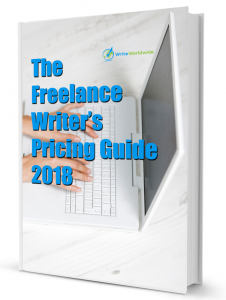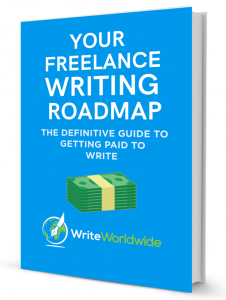Hi WriteWorldwide readers, and welcome to the latest in our series of inspirational and advice-packed interviews with professional freelance writers.
Today’s interview is with James Johnson, founder of Freelance Writers School.
Keep reading to find out why James uses the “Upside Down” method to find profitable new writing clients, the pitching goal that kickstarted his successful freelance writing career, and lots more!
1) Hi James, please introduce yourself to the WriteWorldwide readers.
Hey there, my name is James Johnson and I’m the owner and founder of Freelance Writers School.
In 2014 I was a dead-broke shoes-salesman working for minimum wage and in thousands of dollars of debt. But after discovering a way to knock down what I call the “lead dominoes” – the major roadblocks that stand in the way of being a writer – I was able to start and grow a successful freelance writing business.
In 2017 I decided to start the Freelance Writers School to teach people what I learned. My goal is to help 1000 freelance writers, both beginner and intermediate, start and grow their freelance writing business, their way.
2) How did you break into freelance writing?
While I was travelling around America I kept a blog about my travels and random musings. And, well, I fell in love with writing it.
When I get home I decided I wanted to find a way to make money from writing, and set out try and become a blogger. The road was long and hard and didn’t help me chip away at the debts I had in the short-term. So, I tried to find another way.
One evening a friend showed me a website called Elance (now UpWork) and that there were thousands of people looking for writers like me. I was dubious, but I spent the next few weeks applying for jobs. I was able to land a gig writing an eBook for a fitness company – like $250 or something – and I got a taste that this freelance life might be a viable way to live.
I don’t recommend people try and break into freelancing the same way I did, though. Elance was a different beast back then. But, I’m sure we’ll cover that later.
3) What steps did you take to launch your freelance writing career and how quickly did you see results?
I’m a huge believer in action.
I set myself the goal of earning the same per month, for three months, that I was earning at my day job. I typed it onto a piece of paper in large font, printed it out, and hung it above my laptop.
The first step was to get portfolio pieces. I pitched for guest posts on industry sites in my niches. I would then take the portfolio pieces – and the data about the shares and comments they’d gotten – and include them into my pitches.
My goal was always to pitch 10 people per day. I couldn’t go to bed until I got to 10 people. Which, sometimes, meant I was still at my computer at 02:00 trying to find people to pitch. But I always found a way to get them in.
Using this intensive strategy it was only around six weeks before I’d started to equal my full-time income and I was earning more by the time I quit the job.
4) Tell us about some of the challenges you’ve faced. How did you overcome them?
The biggest challenge I’ve faced is having an unusually conversational writing style.
For some people it can be too fast talking, too aggressive, or too direct. Different strokes for different folks, I guess. But it was a real barrier earlier in my career.
But instead of trying to change my style I changed who I was pitching to. I began to find people who needed my style of writing. This was often people in tech companies, or SEO marketers, who were great at what they did, but couldn’t put it into an easy-to-digest format.
Pairing with people who my writing complimented was a great success, and they often shared the qualities I needed in an editor or ideal client. Win/win for both of us.
5) What’s the one piece of advice you wish someone had given you at the start of your writing career?
Outline the clients you want to work with and look for them.
I spent a lot of my career trying to find work from anybody who would pay me. If they had a bank account, with enough left over for me, I would work with them. I didn’t really think about who they were or if they were the right client for my business.
This lead to a lot of headache and heartache over the years. I would get stressed and depressed doing work I hated for money I didn’t really need.
When I started to outline the clients I wanted to work with, though, that all changed. I began to attract them and develop enjoyable working relationships.
6) What techniques did/do you use to grow your business?
One of the best techniques I used was what I call the “Upside Down” method.
Instead of battling on job board or trying to convince businesses to hire their first ever freelance writer, I’d look for clients who were already warm to them.
I’d do this by finding the portfolios of other writers in my niche – through their guest blog posts or bylined pieces – and then pitch the companies they were working with.
Now, this wasn’t to poach work. This was for the opportunity to join their writing team. And, often, they had the budget to work with me too. I was able to reduce the amount of pitching I’d have to do down to just one or two a week, with a high response rate.
7) What’s the most effective method you’ve used to find new clients?
I kind of answered this above, but I’ll add another one for good measure.
Guest posting on industry blogs – for free – has been invaluable to finding new clients. Although you don’t really have control over when people come to you from them, I find my highest paying clients do.
They’ll read what you’ve written and like your style and come to you to ask about your rates. You’re in the driver’s seat, and they’re often willing to pay much higher rates.
8) What does your daily routine look like?
I have quite a well defined routine. But, I don’t want to seem like I’m perfect and do this every day. Some days it doesn’t work out and I just wing it.
My ideal day looks like this:
07:00 – Wake Up
07:15 – Meditate with the Headspace App
07:30 – Journal
07:50 – Cycle to Gym
08:00 – Strength training
10:00 – Back home, turn phone off, sit down to write (Client work)
12:00 – Eat breakfast (I do intermittent fasting)
12:30 – Check email, respond to Facebook comments etc.
13:00 – Phone off, client work
14:30 – Break
15:00 – Client work or Freelance Writers School work
17:00 – Finish
I try to put a set “end time” to my day every day. It sharpens the mind and forces you to get lots of work done by then.
Turning my phone off is also the biggest productivity hack I have.
9) Who are your biggest influences and people you admire in the freelance writing industry?
See, I’m going to look like a dick now. I don’t really have a lot of influences in the freelance writing industry.
I like Jorden Roper’s branding. I like Ed Gandia’s podcast style. Chelsea Baldwin is a good online friend and does some great work over at CopyPower.
My biggest influences come from outside the industry: James Altucher, Ramit Sethi, Jeff Goins, Lewis Howes, Tim Ferriss. They’re probably all really cliché, but their stuff has made a huge impact on my life.
10) Name one book, one tool, and one article that have helped you in your career.
Write to Sell by Andy Maslen is my writing bible. It taught me everything I need to know about how to create crisp, clear, writing for people. I recommend it to everyone.
Google Docs are the backbone of my business. Everything runs through them. It’s not fancy, but they’re vital.
How To Blast Out Of Obscurity is, ironically, quite an obscure article. But I’ve never read an article more often than this one, especially at the start of my business.
11) How do you keep your writing skills sharp?
I write.
I look for weaknesses in my writing and try to improve them.
Some weeks it might be introductions. Others it might be storytelling. Whatever. I just find something I suck at and try to make it better.
But I stay sharp by writing. Lots.
12) What advice would you give other writers looking to break into the industry.
Take action; be patient.
Check out Jame’s site, Freelance Writers School for more information about transforming your life through freelance writing.




James, I’m intrigued. You say “The biggest challenge I’ve faced is having an unusually conversational writing style” and yet this page is not what I’d call unusually conversational. Thoughts?
On the other hand, your “Upside Down” approach is sensible, eliminating the hit and miss aspect of cold emailing. I’m early in the process of implementing it for my health writing business.
And “How To Blast Out of Obscurity” looks awfully promising. I’m off to see what nuggets I can harvest there…
Gary
Hey Gary,
Thanks for your comment!
For readers it’s not always too conversational, however, for editors it can often be seen as too conversational for the image they want to put forward.
Unusually conversational is a relative term, I guess. What may be unusual for one niche could be fine in another niche. In Internet Marketing you can talk straight and swear and use GIFs and it’s fine. But, say, for B2B insurance, they want a higher-brow style of tone.
This can depend on the company and the target audience as well.
Best of luck with writing and I’m happy to help however I can 🙂
This write-up has elevated my spirit and taught me more on freelance writing biz. Am sure now that I too can make it as a freelance writer.